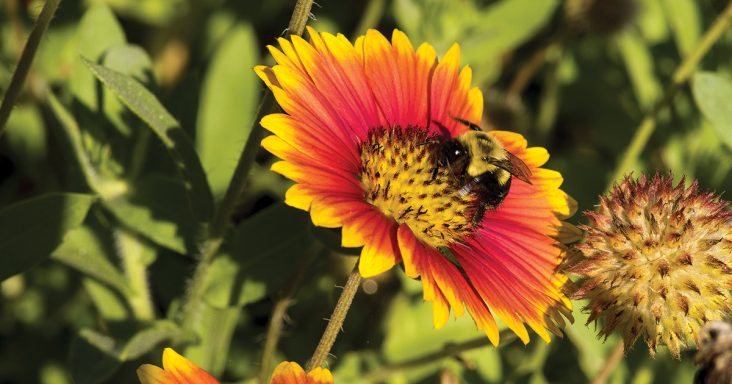‘Lazy mowing’ could aid state’s bee population
by April 11, 2022 7:07 pm 1,931 views

A declining bee population will have all sorts of negative ramifications for food production, but there is one small way Arkansas residents can help these insects pollinate their surroundings.
Researchers with the University of Vermont suggest delaying spring mowing so flowers like dandelions can provide early season food resources to pollinators. Those food sources are important to pollinators such as bumble bees, mason bees and others that emerge in March.
Early spring mowing can also destroy any chrysalises still clinging to last year’s grass and any overwintering shelter for later-appearing pollinators, according to the Xerces Society for Invertebrate Conservation.
“Dandelions are weeds to some homeowners, but to foraging bees, they can be a welcome treat in otherwise barren urban lawns,” said Jon Zawislak, assistant professor of apiculture and urban entomology for the University of Arkansas System Division of Agriculture.
Zawislak said flowers in the dianthus family are very good sources of pollen as are those of the Virginia creeper. Clovers and lilies are also good spring sources for pollinators.
“While most people never notice the small flowers on this ubiquitous climbing weed, bees certainly do,” he said. “Holly is another plant with small, easily overlooked flowers, but it’s starting to bloom right now, and may be covered with bees on a warm day.”
When trees begin to bloom it provides another vital resource for bees.
“Early in the season, flowering trees are very important sources of pollen for bees,” he said. “In particular, maple, willow and ash trees provide a lot of nutrition, even though we don’t see them as having bright showy flowers.”
“Many things in the Rosaceae family such as pears, crabapple and wild plum, bloom briefly in the spring but with lots of flowers for bees,” Zawislak said. “The exception is Bradford pear, which nobody seems to like, except maybe the people who build parking lots. These are fast growing trees, which makes them weak, and are not attractive to pollinators, and provide no edible fruit later for birds or other wildlife.”
As summer unfurls, lawns should be mowed less to aid bees.
“Research published by the University of Massachusetts Amherst and the U.S. Forest Service suggests that homeowners can help support bee habitat in suburban environments simply by changing lawn-mowing habits,” he said. “Investigators found that taking a ‘lazy lawn mower’ approach and mowing every two weeks rather than weekly could help encourage bee habitats in suburban lawns by allowing flowers to bloom, which helps provide pollinators with more nutritious forage.”
Research Ecologist Susannah Lerman and Joan Milam, adjunct research fellow at UMass and were co-authors of the study “To mow or to mow less: Lawn mowing frequency affects bee abundance and diversity in suburban lawns.”
Milam said she was amazed at both the diversity and abundance of bees their team documented in residential lawns.
“It speaks to the value of the untreated lawn to support wildlife,” she said.
Research ecologist Susannah Lerman said the conclusions are “a reminder that sustainability begins at home, and in this case involves doing less for more buzz.”
Bees are big business in the agriculture industry.
The insects pollinate about one-third of the world’s food supply, according to Sustain, a nonprofit agriculture policy organization. Bees pollinate all manner of fruits, vegetables, crops, and even some of the wild grasses used to feed cattle and other livestock.
Their impact on the U.S. economy is valued at about $15 billion per year, according to Scientific American. During the winter of 2018-19 bee keepers across the country lost an estimated 38% of their honeybee colonies mostly due to an Asian parasitic mite that is resistant to some pesticides that kill mites.
Arkansas has about 100 species of bees.
